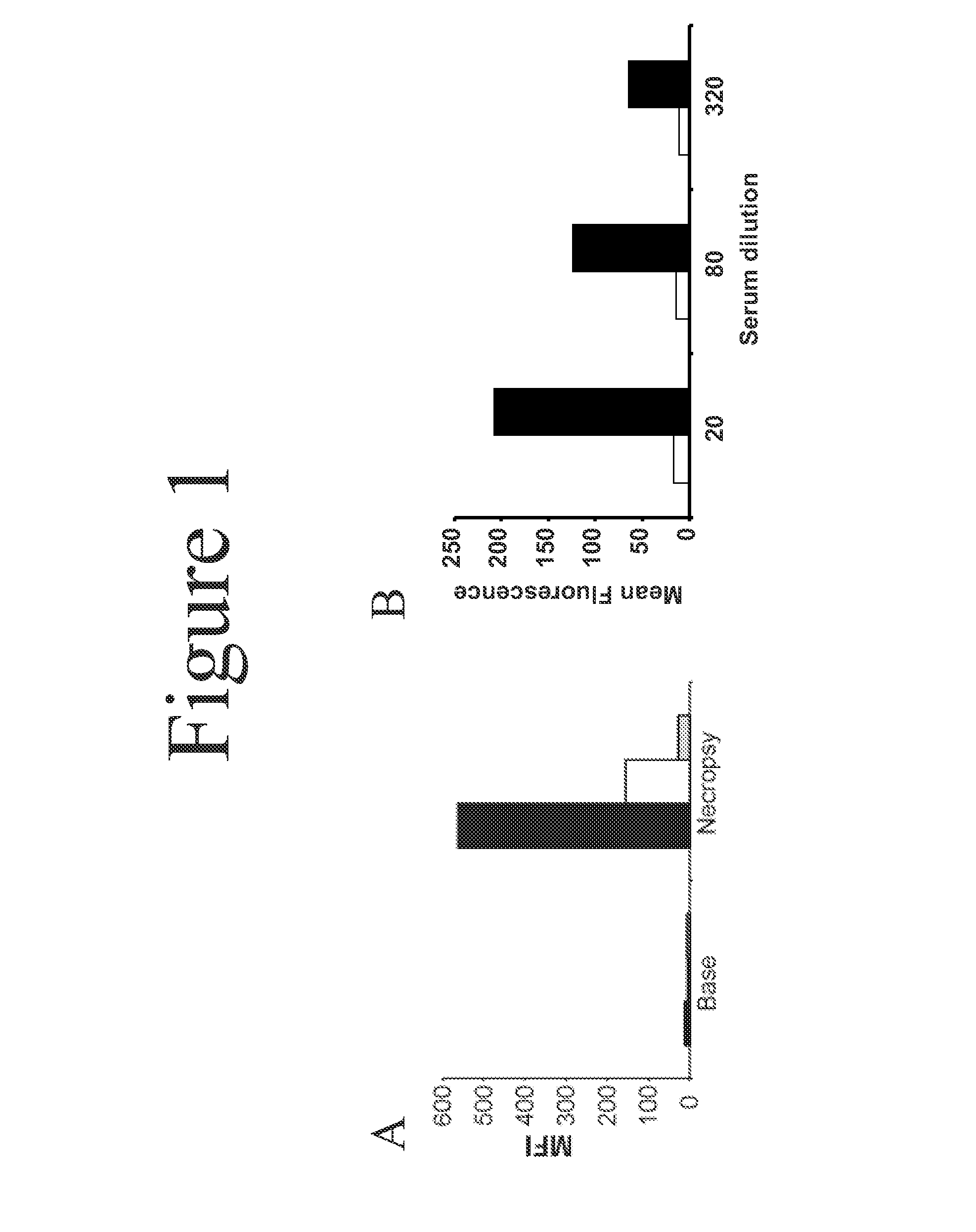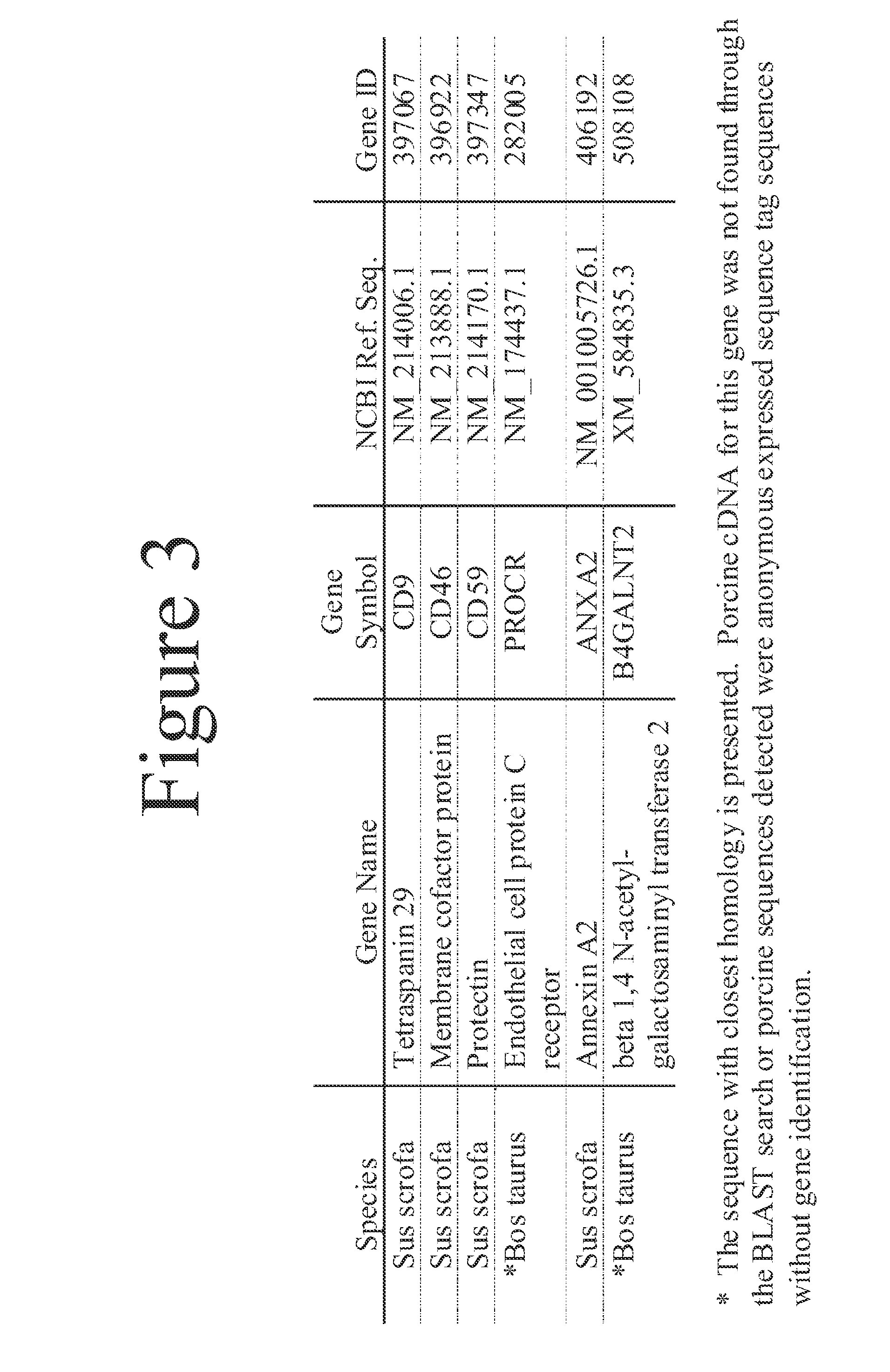Methods and materials for reducing cardiac xenograft rejection
a technology of xenograft and pig, which is applied in the field of methods and materials involved in reducing cardiac xenograft rejection, can solve the problems of chronic shortage of organs for transplantation, limited xenotransplantation, and devastating hyperacute graft rejection usually within hours, so as to prolong the durability of xenograft, reduce the immunogenicity of pig, and reduce the rejection rate
- Summary
- Abstract
- Description
- Claims
- Application Information
AI Technical Summary
Benefits of technology
Problems solved by technology
Method used
Image
Examples
example 1
Identifying Non-Gal Antigens Present on the Endothelial Cell Membranes of Pig Hearts Involved in Immunologic Xenograft Rejection
[0046]Heterotopic pig-to-primate cardiac xenografts were performed using GT-positive and GTKO donor hearts without immunosuppression. See Davila et al., Xenotransplantation, 13(1):31-40 (2006). Sera obtained at necropsy was screened by flow cytometry to measure IgG binding to GTKO porcine aortic endothelial cells (PAECs). Serum from both GT-positive and GTKO recipients showed an induced antibody response to non-Gal antigens as evidenced by increased IgG binding to GTKO PAECs in necropsy sera compared to pre-transplant sera (FIG. 1). This necropsy sera was used for the library screen.
[0047]A standard cDNA expression library was produced using mRNA from GT-positive and GTKO porcine aortic endothelial cells. This library (pRETRO-PAEC) was made in the pRetro-LIB vector (Clontech, FIG. 2A) and was co-transfected with pVSV-G (encoding an envelope glycoprotein fro...
example 2
Engineering a Targeted Disruption in the Porcine B4GALNT2 Nucleotide Sequence
[0054]The cDNA sequence of porcine B4GALNT2 and its conservation in human and mouse provides the needed information to design a targeting vector suitable for disrupting the porcine B4GALNT2 gene using the standard methods of homologous recombination. The amino acids encoded by the nucleotides of individual exons in the human and murine genes show conservation (FIG. 6). This is a common observation in mammalian genes when exons from different species encode the same or similar portions of a polypeptide. This conservation suggests that the porcine B4GALNT2 gene is made up of 11 coding exons and suggests the approximate location for exon boundaries within the porcine cDNA.
[0055]The porcine, human and murine B4GALNT2 cDNA sequences exhibit a high level of conservation in the region that encodes the C-terminal portion of the polypeptide. This region of the human B4GALNT2 cDNA sequence encodes a portion of the B4...
example 3
Monitoring the Progress of Pig Heart Xenograft Rejection
[0058]Utilizing cDNAs encoding the polypeptide non-Gal antigens identified herein, HEK cell lines were developed expressing each of the polypeptide non-Gal antigens with the exception of B4GALNT2. These cell lines were directly used to monitor non-Gal antibody responses to individual non-Gal antigens (i.e. CD46, CD59, CD9, PROCR and ANXA2). Stable HEK cell lines expressing each of these cDNAs were incubated with pre-transplant and necropsy serum (diluted 1:40) from a non-immunosuppressed heterotopic cardiac xenograft recipient. Antibody binding was detected using a FITC conjugated anti-human IgG. Flow cytometry was used to determine the antibody response to each of the antigens (FIG. 12). The xenograft recipient had a strongly induced antibody response to the B4GALNT2 antigen and PROCR, a less intense though positive response to porcine CD9 and CD46 and a minimal response to porcine CD59 and ANXA2. This same strategy can be use...
PUM
 Login to View More
Login to View More Abstract
Description
Claims
Application Information
 Login to View More
Login to View More - R&D
- Intellectual Property
- Life Sciences
- Materials
- Tech Scout
- Unparalleled Data Quality
- Higher Quality Content
- 60% Fewer Hallucinations
Browse by: Latest US Patents, China's latest patents, Technical Efficacy Thesaurus, Application Domain, Technology Topic, Popular Technical Reports.
© 2025 PatSnap. All rights reserved.Legal|Privacy policy|Modern Slavery Act Transparency Statement|Sitemap|About US| Contact US: help@patsnap.com



